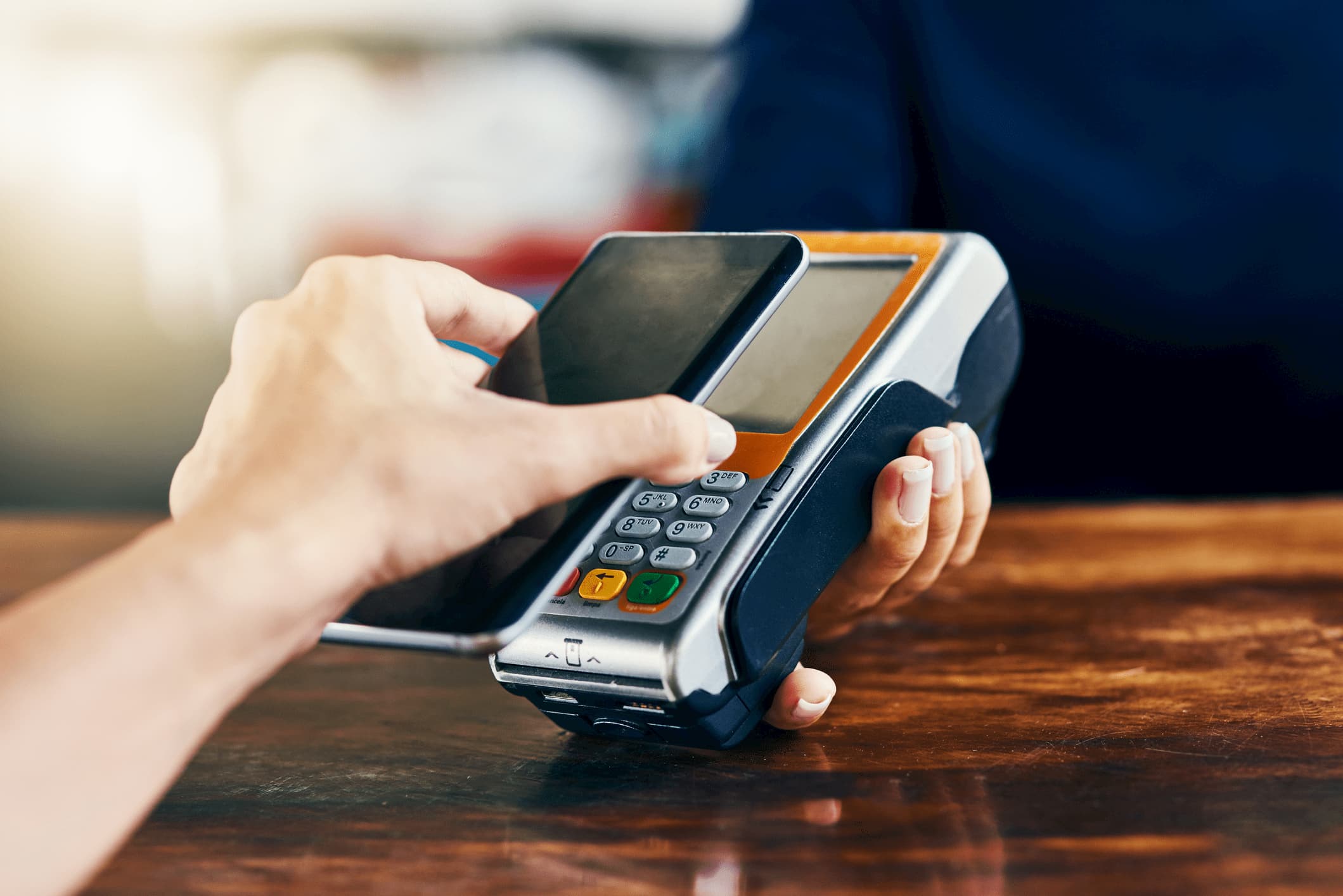Broad market power and positioning at the customer interface drives market share in payments to large platforms
Nobody likes to pay, but if you have to, as a private consumer it generally doesn’t matter how you pay. It should cost nothing, and the payment should go through without any further effort – preferably automatically and smoothly.
There are now a whole host of common (credit card, debit card, direct debit, etc.) and less common non-cash payment options (Apple Pay, Klarna, paydirekt, Yapital, etc.) at the point of sale (PoS) or online.
However, new payment methods introduced in the past were only partially successful. Behind this is the convenience of consumers, who only switch to a new service if there is a noticeable advantage or if – as a result of the exceptional situation relating to the coronavirus, there are major shifts in the use of cash.[3] For example, PayPal with its buyer protection has managed to attract 361 million active customers worldwide to its payment option despite the slight additional effort required by consumers to set up the payment option[4].
However, due to the already high market coverage, large platforms can turn the game around as they can provide a simple solution in existing structures with their payment methods. So customers don’t have to do anything more than click on the (possibly new) “Pay” button in familiar structures. In addition to smooth processing, however, the focus remains on the market power of the respective platform. This is because it is only worthwhile for merchants to integrate a payment solution if there is a high level of market coverage, as this means that many customers can be reached with this attractive payment option.
There are already numerous platforms that have a large market coverage. For example, more than one in two Germans is an Amazon customer[5] one in five owns a smartphone from Apple[6] and one in four has an account on Instagram[7].
Another important factor in gaining a foothold as a platform with a payment option is a strong presence at the customer interface related to payments. Thus, the platform is already known to the customer through their processes and the associated payment option. For example, Instagram might have a harder time gaining customers’ trust for payments solutions, as the platform currently has little association to payments. However, the social media platform could benefit with customers via the items already offered in the app with a payment solution that is smoothly integrated into the purchasing process.
It is no surprise that one of the largest platforms is already pushing into payments with a comprehensive solution. With Amazon Pay, the e-commerce giant has a payment option that allows customers to use their Amazon account only for the last step, the payment, at third-party shops, for example. This means that online shoppers do not have to register with new shops or re-enter all their data for a one-off purchase.
The current development in payments does not initially represent a groundbreaking change, because e-commerce payments continue to be processed via a provider who in turn combines various means of payment in their solution (direct debits, credit card payments, etc.). PayPal works no differently.
But large platforms act with broad market power at the customer interface and dominate who their customers live and act to a degree. This puts platforms in the best position to fully serve their payments customers. We therefore expect at least one large platform to establish itself as a common payment method, while smaller platforms and providers will become dependent on using the large platform’s payment solution – for example, a small merchant who can only gain customer trust with Amazon Pay.
BankingHub-Newsletter
Analyses, articles and interviews about trends & innovation in banking delivered right to your inbox every 2-3 weeks
"(Required)" indicates required fields
Credit card vs. PayPal – it is not easy to surpass the top dog PayPal in payments by taking the same approaches as always
“What do you need a credit card for? You can always use PayPal!” The teenage son of one of the participants of a discussion panel on payment transactions asked this question a few years ago. And even today, looking at the way credit cards are designed, some things seem strange: credit card numbers are valid for a few years, their expiry date and the three-digit code on the back are considered to be the “security code” and these supplemented by other security features such as SecurePay… today’s idea of security features are much more advanced.
For the customer, the credit card (at least as far as paying online is concerned) is a payment method that stands alongside new offerings like PayPal. And even if technically PayPal is a small upstream extension of a card, both offers are in direct competition for the customer interface: for the customer the payment method “credit card” stands next to the payment method “PayPal” and next to various other options. Credit card providers are well aware of this, which is why they are in the process of making the setup that has existed for 40 years fit for the future: Visa, for example, has innovation centers around the world, and Mastercard has also launched various initiatives, including about authentication or payment with wearables.
The credit card continues to be a payment method with increasing user numbers in 2021, benefiting from the coronavirus-accelerated move away from cash and offering many advantages to remain the “top of wallet” for many people. In addition to being already established, as mentioned before, these benefits include the trust already gained by payers and payees.
In other words, will credit cards suffer the same fate as PayPal or ApplePay / Google Pay as many other “hardware manufacturers” whose products are degraded to the status of accessories for a software provider? Examples of this include some car manufacturers whose products, such as Apple’s CarPlay or Google Car’s Android Auto, form the interface to the driver. This could also happen to the credit card. Software manufacturers benefit over hardware manufacturers in terms of convenience for the user, among other things. Kind of like how it’s convenient with PayPal to store your credit card once and only update the data in one place when the card expires. Or when, for example, you can choose to pay with PayPal when purchasing in an online shop instead of typing in a 16-digit number, an expiry date and security code every time.
The question is what it takes to get to or past PayPal. If we take a look at offers such as Amazon Pay or Klarna, which operate in a similar way to PayPal (i.e. that they both have a contact with the merchant and appear in front of the buyer), then this is usually a mixture of convenience in the transaction for both buyer and merchant, integration into an existing ecosystem, overcoming the “chicken and egg problem[8]” and a portion of trust that the provider enjoys. These hurdles are high, and there are quite a few market participants who have not overcome them. But as the two examples given show, it is not impossible.
Cash will not disappear completely
In an era of globalization and digitalization, it goes without saying that payments are also increasingly being made digitally. In the last 13 years since the global financial crisis of 2008, the worldwide shift to digital payment channels has continued at an impressive pace. The frontrunner here is China, for example, where mobile payments have increased from less than 4 percent in 2011 to over 83 percent in 2018[9]. This contrasts with countries such as Italy or Spain, where over 71% of payments in the retail segment were still made in cash in 2018[10] – where people still believe “cash is king”.
Let’s analyze the pros and cons of cash payments and digital payments in a little more detail.
Disadvantages of digital payments vs. disadvantages of cash payments
Obviously, the biggest weakness of digital payments for private consumers is that each of their movements can be precisely analyzed and traced – but also that this payment option requires a receiving device (e.g. POS terminal). Customer’s behavior, mobility behavior and shopping habits are the subject of the analysis of the companies behind the scenes.
On the other hand, cash must always be carried in sufficient quantities of the correct currency, takes up space in your wallet and in the case of coins, can also be heavy. It needs to be withdrawn before use and it can be stolen, lost or even destroyed unintentionally.
Advantages of digital payments vs. advantages of cash payments
The benefits of digital payments are the freedom to pay with a payment instrument at any time, in any country (provided a receiving device is available) and in any currency. It works everywhere as long as there are sufficient funds; direct debits can be reviewed immediately in apps or in Internet banking, and receipts and expenditures are recorded automatically.
The main arguments in favor of cash are the anonymity of the payment, the universal acceptance worldwide as long as the payment is made in the correct currency, and the direct settlement of a transaction. In addition, unlike electronic payments, a merchant does not have to pay a direct fee, and paying through real physical money tends to result in more frugal consumer behavior.
Shifts in payment behavior
Shifts in payment behavior are occurring in many countries around the world and the payments landscape is becoming increasingly digital because the typical consumer often doesn’t mind whether payments are recorded and it is more comfortable to use one payment instrument for all money matters.
Nevertheless, cash is a living cultural value, part of our understanding of payment and values, and a component of non-transparent markets that vary in strength from country to country but nevertheless clearly exist. As such, currency and national identity in most countries cannot be entirely dismissed. Many governments are planning to enshrine a legal right to cash in their constitutions.
The authors of this article believe that cash will decrease in relevance due to the convenience of many people, however, a “base” will be maintained as there will continue to be situations and people who prefer cash.








